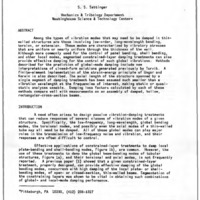-
Title
-
Directional Damping Of The Global Vibration Modes Of Tubular Structures By Constrained-Layer Treatments
-
Report Number
-
WL-TR-91-3078 Volume III, p. HBA-1 thru HBA-18
-
Creator
-
Sattinger, S.S.
-
Corporate Author
-
Mechanics & Tribology Department, Westinghouse Science & Technology Center
-
Date
-
1991
-
Date Issued
-
1991-08
-
Extent
-
18
-
Identifier
-
AD241313
-
Format
-
1 online resource
-
Abstract
-
Among the types of vibration modes that may need to be damped in thin walled structures are those involving low-order, long-wavelength bending, torsion, or extension . These modes are characterized by vibratory stresses
that are uniform or nearly uniform through the thickness of the walI. Although more commonly used for the control of panel bending, shelI bending, and other local modes, segmented constrained-layer damping treatments can also provide effective damping for the control of such global vibrations. Methods described for the prediction of global-mode damping include new interpretations of closed-form solutions generated previously by Torvik. A
finite-element implementation of the strain-energy principle of Ungar and Kerwin is also described. The axial length of the structure spanned by a single segment of damping treatment has been assumed much smaller than a vibration wavelength at the frequencies of interest, making static or quasistatic analyses useable. Damping loss factors calculated by each of these methods compare wel I with measurements on an assembly of damped, hollow, rectangular-cross-section beams.
-
Description
-
Among the types of vibration modes that may need to be damped in thin walled structures are those involving low-order, long-wavelength bending, torsion, or extension . These modes are characterized by vibratory stresses
that are uniform or nearly uniform through the thickness of the walI. Although more commonly used for the control of panel bending, shelI bending, and other local modes, segmented constrained-layer damping treatments can also provide effective damping for the control of such global vibrations. Methods described for the prediction of global-mode damping include new interpretations of closed-form solutions generated previously by Torvik. A
finite-element implementation of the strain-energy principle of Ungar and Kerwin is also described. The axial length of the structure spanned by a single segment of damping treatment has been assumed much smaller than a vibration wavelength at the frequencies of interest, making static or quasistatic analyses useable. Damping loss factors calculated by each of these methods compare wel I with measurements on an assembly of damped, hollow, rectangular-cross-section beams.
-
Distribution Classification
-
1
-
Distribution Conflict
-
No
-
DTIC Record Exists
-
No
-
Illinois Tech Related
-
No
-
Photo Quality
-
Complete
-
Report Availability
-
Full text available
-
Type
-
article
 article HBA
article HBA